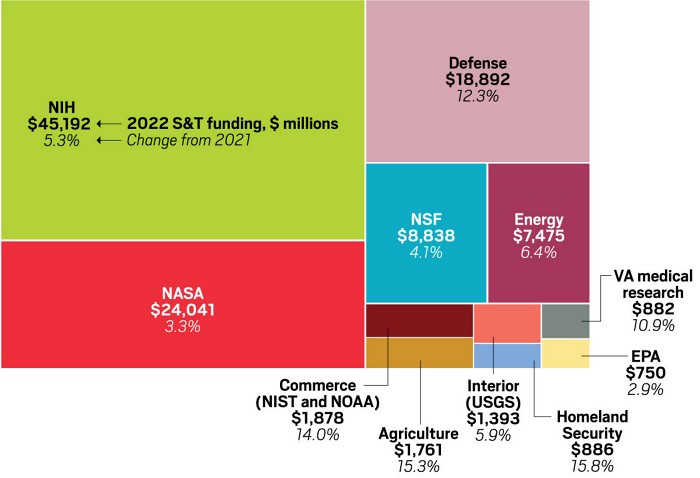Advertisement
Grab your lab coat. Let's get started
Welcome!
Welcome!
Create an account below to get 6 C&EN articles per month, receive newsletters and more - all free.
It seems this is your first time logging in online. Please enter the following information to continue.
As an ACS member you automatically get access to this site. All we need is few more details to create your reading experience.
Not you? Sign in with a different account.
Not you? Sign in with a different account.
ERROR 1
ERROR 1
ERROR 2
ERROR 2
ERROR 2
ERROR 2
ERROR 2
Password and Confirm password must match.
If you have an ACS member number, please enter it here so we can link this account to your membership. (optional)
ERROR 2
ACS values your privacy. By submitting your information, you are gaining access to C&EN and subscribing to our weekly newsletter. We use the information you provide to make your reading experience better, and we will never sell your data to third party members.
Research Funding
US Congress finalizes 2022 spending bill
Most US federal agencies get notable increases in science funding
by Britt E. Erickson , Andrea Widener , Cheryl Hogue
March 16, 2022
| A version of this story appeared in
Volume 100, Issue 10
Nearly 6 months late, Congress passed a $1.5 trillion spending bill to fund the federal government for the remainder of fiscal 2022, which ends Oct. 1. Lawmakers sent the omnibus bill to President Joe Biden on March 11, and he signed it into law March 15.
Compared with other spending bills passed in recent years, the 2022 omnibus gives most agencies significant increases, albeit ones far lower than those requested by the Biden administration.
2022 US funding for science and technology

Note: Funding for select science and technology agencies and programs. Total 2022 R&D funding is $169 billion, a 7.1% increase over 2021.
The National Institutes of Health sees an overall increase of 5.3% to $45 billion. Within the NIH, the National Institute on Aging gets a 8.2% increase to $4.2 billion. Most of that money will go to Alzheimer’s disease research. The National Institute on Drug Abuse sees a 7.8% increase to $1.6 billion. The National Institute on Minority Health and Health Disparities also gets a large bump of 17.2% to $459 million.
Biden’s new Advanced Research Projects Agency-Health (ARPA-H) is funded under the bill at $1 billion, which is far less than the $6.5 billion the president had proposed. ARPA-H is designed to speed the development of health-research technologies.
The National Science Foundation receives $8.8 billion, a 4.1% increase. That is far below the almost 20% increase the Biden administration had originally proposed. The bill does not set out specific funding for a new technology and innovation directorate, though the NSF has been working on creating it.
In the Department of Energy’s Office of Science, Biological and Environmental Research gets an 8.2% increase to $815 million, while Fusion Energy Sciences sees a 6.1% boost to $713 million, far above the president’s flat request.
The National Institute of Standards and Technology gets a 19% boost to $1.2 billion. The president had requested an almost 200% increase in the institute’s manufacturing programs, but those got a 5% increase instead.
The Food and Drug Administration gets $29.5 million for food safety, some of which is to address heavy metals in baby food. Congress also gave the FDA authority to regulate synthetic nicotine in e-cigarettes and other products. The provision closes a loophole that some e-cigarette makers were exploiting to sell flavored products after the FDA banned flavored e-cigarettes. Within 30 days of enactment, the FDA will be able to restrict flavors in tobacco-free nicotine products.
The US Department of Agriculture’s competitive research grant program, the Agriculture and Food Research Initiative, gets a $10 million or 2.3% increase for a total of $445 million. The Agricultural Research Service, the USDA’s intramural research program, gets a 15.3% increase, although some of that money is earmarked for buildings and facilities. Congress also gave the USDA $1 million to plan an ARPA-like advanced agricultural research program.
The Environmental Protection Agency’s budget is essentially flat. The omnibus provides $750 million, a 2.9% increase. The spending law does, however, authorize the agency to employ additional scientists, including chemists, for the agency’s research- and chemical-control programs under a special hiring authority. Called Title 42, this authority permits federal employees to earn salaries higher than the typical civil service pay cap, which was $172,500 in 2021. The goal is to allow the EPA to compete with the private sector and academia for highly skilled workers.
From 2014 until now, the agency’s Office of Research and Development could employ up to 50 people at one time under this authority. The 2022 spending law raises this limit to 75 people. In addition, it allows the EPA Office of Chemical Safety and Pollution Prevention, for the first time, to employ people under this authority, with the number capped at 25.





Join the conversation
Contact the reporter
Submit a Letter to the Editor for publication
Engage with us on Twitter